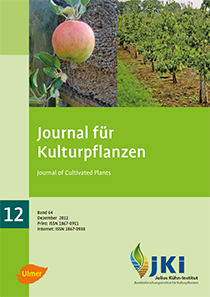Monitoring of total copper contents in organically and conventionally managed soils. Part 4: – Total contents in German pomiculture soils
DOI:
https://doi.org/10.5073/JfK.2012.12.01Keywords:
Total contents of copper, control of fungi, Venturia ssp., Nectria galligena, organically and conventionally managed pomiculture soils, load situation in pomiculture, risk potential, exposure assessment, preselection of adequate monitoring areasAbstract
Implications of long-term usage of copper fungicides on sustainable soil quality have been described for a long time, and according to the regulation of active substances, are objective of a survey on copper contents in agricultural soils in several EU member countries.
1613 single samples from the soil horizon 0–5 and 5–20 cm were taken from 40 organically and 12 conventionally managed pomiculture sites trying to make reference to all aspects relevant for a representative assessment of copper loads. The result of that survey is intended to enable the selection of site-typical types of cultivation being the prerequisite of an assessment of effects to the earthworm coenosis in combination with a refined exposure analysis.
On the basis of total contents, the copper load and their distribution on test and reference fields of German pomiculture cultivation sites is presented including the minimum, maximum and mean value as well as percentiles. Additionally, the heavy metal content in general was determined and differences in copper contents between tree row and driving lines were identified.
Comparing managing history and current management, it is obvious that load peaks result from copper applications between 1960 to 1995, when between 10 to 13 kg copper per ha and year were applied to control plant diseases. The evaluation of bio available copper, resulting from aged total copper contents, is not yet completely finished.
By means of data, generated in preliminary samplings concerning load situation, site description and duration of management, 2–3 pomiculture sites are suggested being appropriate to assess the recent situation of soil quality in terms of responses on a population level.
Downloads
Published
Issue
Section
License
The content of the journal is licensed under the Creative Commons Attribution 4.0 License. Any user is free to share and adapt (remix, transform, build upon) the content as long as the original publication is attributed (authors, title, year, journal, issue, pages).
The copyright of the published work remains with the authors. The authors grant the Journal of Cultivated Plants, the Julius Kühn-Institut and the OpenAgrar repository the non-exclusive right to distribute and exploit the work.







